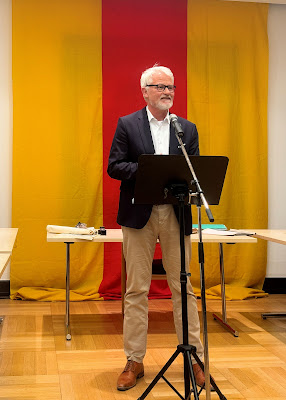I thought everything had been said and written on the topic. Still, the Neue Zürcher Zeitung (NZZ) recently revived the issue in an article titled "Ionizing radiation increases the risk of cancer, but does this also apply to the smallest doses?"
In international recommendations and national regulations, the annual dose limit for people occupied as "radiation workers" in a radioactive environment is 20 mSv. In contrast, the yearly limit for the population at large is 1 mSv.
Still, some scientists regard this limit as too high. On the other hand, no increased cancer rates are observed in a population living on the black sands of Kerala* in India, in a natural environment of more than 80 mSv annually.
*These sands contain naturally occurring radioactive Thorium
Red Baron always thought that the LNT hypothesis (orange in the above graphic)
was too conservative and regarded radiation protection measures that even go
beyond that assumption as overdone and uneconomical.
One recent example is the release of stored cooling water from the site of the reactor accident in Fukushima. After cleaning the contaminated water from radioactive cesium and strontium, only tritium remains as a radionuclide. The treated water is diluted with seawater until it only contains 1500 Bq/l (Becquerel per liter), or one-seventh of what the World Health Organization recommends as the tritium limit for drinking water. Although you could drink the water released from the radiation protection point of view, it is too salty.
All nuclear power plants discharge tritium-containing water well below the limit into seas and rivers during operation. The amount that will now be discharged in Fukushima per year into the Pacific over a 30-year period is about the same as the amount that the Fukushima power plant already discharged into the ocean while in operation.
The International Atomic Energy Agency (IAEA) approved the dumping of the tritium-containing water and declared that Japan meets international safety standards. An IAEA team of experts is on-site monitoring water discharge into the Pacific.
Tritium has a relatively short biological half-life. So when inhaled or ingested through food, it is excreted again after a relatively short time.
As a soft beta emitter, tritium emits relatively low-energy radiation that we shield with our skin layer. Therefore, radiation doses due to external exposure from tritium during swimming are irrelevant.
Still, Japanese fishermen in the region resisted the release, fearing a loss of income.
China brought out the big gun: "Forcibly discharging into the ocean is an extremely selfish and irresponsible act that disregards the global public interest." The Foreign Ministry in Beijing went on to say that Japan had become a saboteur of the ecological system and a polluter of the global marine environment. In response, China stopped all imports of seafood from Japan.
The environmental organization "Greenpeace Japan" also criticized the action as the "wrong solution" and spoke of "decades of deliberate radioactive pollution of the marine environment."
Back to the LNT hypothesis. The relationship is only statistically confirmed
at higher radiation doses. Below an annual exposure of 100 mSv, the estimates
of the increased cancer risk are highly uncertain. Although the study of
cancer cases in atomic bomb victims of Hiroshima and Nagasaki is based on a
large cohort, it suffers from the fact that the Japanese population was
exposed to very high doses of radiation in a very short time.
This fact, which was used as a basis for the LNT hypothesis, has always been criticized because the exposure pattern of an atomic blast is not comparable to the conditions in radiation protection, where people are exposed to low-level radiation over extended periods.
On the other hand, it is proven that even low-level radiation damages DNA, but cells have developed numerous mechanisms in the course of evolution to repair damages. Not every mutated cell necessarily develops into a cancer cell; some simply die.
A few scientists even go one step further, claiming that low doses of ionizing radiation stimulate the immune system, inhibiting cancer formation (hormesis).
Cell experiments cannot scientifically substantiate or falsify the LNT hypothesis that must never be used to calculate the number of deaths caused by tiny doses of radiation. These calculations are meaningless due to the significant uncertainties. However, opponents of nuclear power sometimes use them to spread terror and fear among the population.
Finally, the LNT hypothesis remains the best assumption on radiation effects at small doses. Of all that we know, it puts us on the safe side and remains the working tool for radiation protection until further information.
This fact, which was used as a basis for the LNT hypothesis, has always been criticized because the exposure pattern of an atomic blast is not comparable to the conditions in radiation protection, where people are exposed to low-level radiation over extended periods.
On the other hand, it is proven that even low-level radiation damages DNA, but cells have developed numerous mechanisms in the course of evolution to repair damages. Not every mutated cell necessarily develops into a cancer cell; some simply die.
A few scientists even go one step further, claiming that low doses of ionizing radiation stimulate the immune system, inhibiting cancer formation (hormesis).
Cell experiments cannot scientifically substantiate or falsify the LNT hypothesis that must never be used to calculate the number of deaths caused by tiny doses of radiation. These calculations are meaningless due to the significant uncertainties. However, opponents of nuclear power sometimes use them to spread terror and fear among the population.
Finally, the LNT hypothesis remains the best assumption on radiation effects at small doses. Of all that we know, it puts us on the safe side and remains the working tool for radiation protection until further information.
*





























































